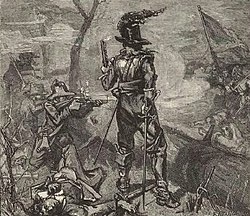Plundering Time
The Plundering Time (1644–1646), also known as "Claiborne and Ingle's Rebellion", was a period of civil unrest and lawlessness in the English colony of the Province of Maryland. William Claiborne and Richard Ingle took opportunities to seize property and pillage in and around Kent Island and St. Mary's City, Maryland. Causes of rebellionThe causes of the rebellion included William Claiborne's disputed claim with the Calverts over Kent Island, Maryland, bitter relations between the Catholic minority elite and the Protestant majority, and the political partisanship of the English Civil War.[citation needed] The period was marked by the fall of the British King and religious intolerance, which led directly to the event. Kent Island dispute (1638-1644)
 In the winter of 1638-1639 (O.S./N.S.), the first provincial Maryland governor Leonard Calvert seized a trading post on Kent Island established by Captain William Claiborne.[1] In 1644, Claiborne led an uprising of Protestants and reclaimed the Island.[1] Richard Ingle's coup (1644-1646)
Although not officially allied, privateer Captain Richard Ingle seized the Kent Island opportunity to overthrow the government based at St. Mary's City.[1] Catholic Governor Calvert escaped to Virginia. Protestant pirates began plundering the property of anyone who did not swear allegiance to the English Parliament, mainly Catholics. By the end of 1646, Calvert recovered control.[2] End of rebellionIn 1647, the Rebellion was ended by Maryland Governor Lord Baltimore, who successfully led Maryland colonial forces against the Parliamentary privateers and regained control of the colony, effectively ending the rebellion. Aftermath  The Maryland colonial assembly issued the Maryland Toleration Act of 1649 to mollify the two factions. A Parliamentary victory in England renewed old tensions leading to the 1655 Battle of the Severn, now present-day Annapolis. References
Sources
|
||||||||||||||||||||||||||||














